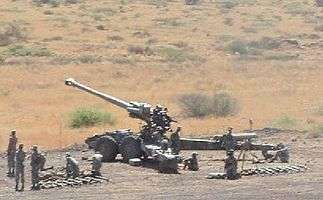Lohatla
| South African Army Combat Training Centre | |
|---|---|
| Lohatla, Northern Cape province, South Africa | |
 | |
 Lohatla Upington Kimberley Lohatla (Northern Cape) | |
| Type | Military Training Area |
| Site information | |
| Owner | Department of Defence |
| Controlled by |
|
| Condition | In use |
| Site history | |
| Built | 1978 |
| In use | 1978-present |
| Garrison information | |
| Current commander | Brigadier General Bhasie Gqoboka |
Lohatla is a training area of the South African National Defence Force. It is located in the Northern Cape province of South Africa and is home to the SA Army Combat Training Centre, which is part of the South African Army Training Formation.
Capability
The SA Army Combat Training Centre is unique in the sense that it is one of only ten such institutions in the world that provide exclusive and permanent facilities for landward warfare training. Only two of these institutions are located in the Southern hemisphere, of which the SA Army Combat Training Centre is the largest, 158 000 hectares in total.[1]
History
This military training institution was founded on 15 January 1978 and was known as the South African Army Battle School. [2]
The Battle School originated due to a need by the Department of Defence for a military training facility where conventional and integrated training on divisional level could be executed.[3]
Nature Reserve
The Ga-Thlose Nature Reserve was proclaimed in 1890 and was managed as its domain by Agricultural Credit. Ownership by the local population was denied through a proclamation in 1976 and the Reserve was proclaimed a restricted military area. The local population living in the area were to be relocated in the passage of time. In the meantime it was agreed that the specific group of the local community could graze their cattle in the designated grazing areas. The movement to Ga-Thlose from the Sishen Gate was also permitted.
Area enlarged
The purchase of farms east and south of the above-mentioned area was completed in 1981 and the area, as a whole, was proclaimed as a restricted military area. The infrastructure taken over from the farmers was in a good condition.
Permanent in house units
During the early nineties, nine self accounting units were permanently based on the terrain:
- 61 Mechanised Battalion Group, (currently integrated into 8 SAI at Upington)
- Training Group,
- HQ Unit,
- 12 Field Engineers Regiment,
- 8 Signals Group,
- 101 Works Unit,
- 16 Maintenance Unit,
- 8 Division Mobilisation Unit and
- a Provost Unit
A Forward Air Command Post and Medical Command Post helped to integrate elements from the Air Force and Medical Service.
Visiting Units
Each unit visiting for training is accommodated in one of thirteen unit lines which has tank paving, maintenance areas and stores.
|
Insignia
|
SANDF era
A long-running land dispute involving the South African Army Combat Training Centre (CTC) at Lohatlha in the Northern Cape ended when the Department of Rural Development and Land Reform found alternative land to settle some of the community displaced by the 158 000 hectare base and training area in 1977. [4]
The institution was renamed the South African Army Combat Training Centre on 24 October 2000.[5] [6]
Annual Exercise Seboka integrated training
Exercise Seboka demonstrates the training of units in operations from each combat discipline. Infantry, Armour, Artillery, Intelligence, Air Defence Artillery, Engineers as well as elements from the Air Force and Military Health Serves are integrated.The exercise gives units the opportunity to plan and execute mobile warfare operations in real time command and control under the supervision of experienced commanders.[7]
Training of the African Standby Force
The Army Combat Training Centre hosted the Amani Africa 2 field exercise to demonstrate the African Unions rapid deployment capability in 2015. The field exercise involved five regional economic communities, as structures of the African Union. Approximately 5,400 members from the military, police, and civilian components, representing four of the regional economic regions of the AU participated in the exercise. Countries involved included Algeria, Angola, Botswana, Burundi, Democratic Republic of the Congo, Egypt, Ethiopia, Gambia, Ghana, Kenya, Lesotho, Malawi, Mozambique, Namibia, Nigeria, Rwanda, South Africa, Swaziland, Uganda, Zambia, and Zimbabwe. [8]
Leadership
| From | Commanding Officer | To |
| 01 March 2005 | Brigadier General J.D. Magasela | 01 December 2007 |
| 01 December 2007 | Brigadier General Nontobeko Mpaxa | 01 March 2013 |
| 01 March 2013 | Brigadier General Bhasie Gqoboka | 31 December 2014 |
| 01 January 2015 | Brigadier General Mawethu Mdlulwa | current |
References
- ↑ http://www.actc.army.mil.za/
- ↑ http://www.defenceweb.co.za/index.php?option=com_content&view=article&id=32707
- ↑ http://www.enca.com/sa-soldiers-prepare-fight-again
- ↑ http://www.defenceweb.co.za/index.php?option=com_content&view=article&id=11060
- ↑ http://www.timeslive.co.za/local/2015/10/07/SA-to-host-large-scale-African-Union-military-exercise
- ↑ http://www.defenceweb.co.za/index.php?option=com_content&view=article&id=32718:new-gallery-exercise-seboka-2013&catid=50:Land
- ↑ http://www.defenceweb.co.za/index.php?option=com_content&view=article&id=41261:iss-african-standby-force-how-the-au-can-get-it-right&catid=56:diplomacy-a-peace&Itemid=111
- ↑ https://www.enca.com/south-africa/sa-readies-host-au-military-field-training
External links
Coordinates: 28°01′41″S 23°06′28″E / 28.0280°S 23.1077°E



